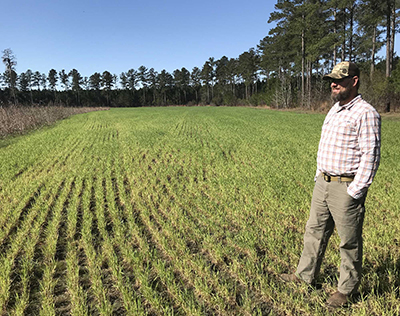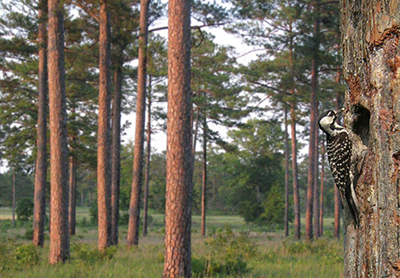
Scott Rhodes plants longleaf pine trees prized by federally endangered red-cockaded woodpeckers. He thins sweet gum, red maple and other hardwoods to create welcoming wetlands for ring-necked ducks, blue herons and woodstorks. And he burns his woodlands to create ideal habitat for numerous species including, one day perhaps, at-risk gopher tortoises.
Rhodes, though, also harvests acres of loblolly pines for mills in nearby Estill and Savannah. He’s a forestry consultant advising Lowcountry landowners on ways to profit from their land. His family’s plantation, Oak Grove, is also a favorite quail, turkey and deer hunting preserve for well-heeled hunters.
And there is no inherent contradiction between the conservationist Rhodes and the capitalist Rhodes. The two mutually benefit each other. Wiregrass, for example, is prime habitat for bobwhite quail as well as tortoises and woodpeckers.
Rhodes exemplifies the maxim of doing good by doing well. And, increasingly — particularly in the South where 85 percent of the land is privately owned — farmers, ranchers, foresters and other landowners hold the keys to conservation. They’ll often take advantage of federal programs, offered by the U.S. Fish and Wildlife Service (Service) and other agencies, to help finance wetlands or habitat work — proof that business and conservation don’t have to be at odds.
“Our goal here is to make the land work for us so we can live off it,” Rhodes said while touring the plantation in his heavy-duty Chevy truck on a cool morning. “But we also want to be good stewards of the land for the non-game species too.”
South Carolina’s Lowcountry, beyond the beaches and the old-world flair of Charleston, is all swamps, pine trees and rivers. Hedgerows and magnolias hide the corn, cattle and gentleman farms along twisty, two-lane black tops. Hunting abounds on the private “plantations” — Red Bluff, Duck Bottom, Deerfield — that cater to Charlestonians, Savannahians and Atlantans with appetites for bobwhite quail, wild turkey and whitetail deer.
An old coach road runs through Oak Grove Plantation and ends at the Savannah River eight miles away. A No Trespassing sign keeps the uninvited from the 4,300-acre tapestry of corn, rice, loblolly and longleaf fields.
Rhodes, 46, grew up in Estill as his father Tommy, also a forester, cobbled together the family cattle and tree farm. His mother, Sandy, is an artist who depicts Lowcountry wildlife in oils, watercolors and pastels.
An ornithology class at the University of Georgia piqued the younger Rhodes’ interest in conservation. A degree from the Warnell School of Forestry cemented his passion for working lands.
“I knew that I wanted to represent landowners,” said Rhodes, a registered forester. “I like to manipulate land and grow trees.”
He manages the farm with his brother-in-law. He’s also a forestry consultant advising landowners in South Carolina and Georgia on timber and land sales. Hunting, though, marries his business acumen with love of the outdoors.

Corporate groups spend $4,500 to quail hunt for two days. Three-day deer and turkey hunts run as much as $2,000 per person. A 35-acre pond stocked with bluegill, shellcracker and largemouth bass beckons out back.
Rhodes and his guides ferry hunters across the plantation by Jeep or horseback. More than 200 covered deer stands dot the landscape. Hunters can choose from 75 different agricultural fields or wildlife food plots, as well as swamps and longleaf habitats.
“At Oak Grove,” its website says, “intensive habitat management has become an obsession for the Rhodes family.”
Fields and trees are carefully managed to maximize the plantation’s three main objectives: hunting; logging and conservation. About 1,500 acres are dedicated quail habitat with wiregrass, broom straw and blue stem along with corn and rice fields. Rhodes put in a weir to control a creek’s flow and keep an adjoining wetlands wet enough for waterfowl, egrets and woodstorks.
He fenced part of a duck pond to keep out deer. Nearly 200 ring-necked ducks took flight from the pond one recent morning. Nearby, a family of whitetail deer meandered into the woods. Fox squirrels scurried up pines. Three quail hurriedly quit the old coach road, unaware that their hunting season ended a few days earlier.
“It was a great year,” Rhodes said. “We harvested in hand 700 quail.”
“They’re committed to a rural, sustainable South Carolina lifestyle where you can cut timber, hunt deer and turkey and generate a living off the land that benefits wildlife habitat and produces clean air and water,” said Robert Abernethy, president of The Longleaf Alliance. The nonprofit works with public and private landowners to boost longleaf acreage across the South.
The iconic tree led Rhodes to the Service. In 2006, Oak Grove received (and matched) a $25,000 Service grant. In return, the Service got added protection for a host of at-risk, threatened and endangered species.
Rhodes agreed to turn 208 acres of farm fields and loblolly stands into longleaf and wiregrass that the Service helped plant. Rhodes also assented to burning his longleaf forest every few years.
Longleaf proponents extol the many habitat benefits — open canopy, fire resistant, woodpecker-friendly — of longleaf. The sturdy, long-living tree once covered 90 million acres from Virginia to Texas. Today, after decades of logging, turpentining, ag development and urban sprawl, roughly 5 million acres remain. The Alliance and the Service are aiming for 8 million acres by 2024.
Rhodes, the Service and the U.S. Department of Agriculture next turned to water. In 2012, he received $10,000 from the Service to boost wildlife — waterfowl, wading birds, migratory birds — on 105 acres of wetlands. Sweetgums and red maples were harvested; an aquatic herbicide rid the sites of unwanted vegetation. More than 2,500 acres is under conservation easement with the agriculture department and The Nature Conservancy.
“Combining longleaf pine with isolated wetlands is so important because it benefits so many species, including Carolina gopher frogs and salamanders, that spend part of their life cycle in wetlands and part in nearby longleaf pine,” said Joe Cockrell, a wildlife biologist who runs the Service’s Partners program in South Carolina. “Most of the people we work with are more interested in trees than declining species.
“Scott is in the minority. He understands the wildlife benefits of longleaf pine.”
And gopher tortoises.
Rhodes says he’s “open” to welcoming the lumbering species, whose eastern range runs from southwestern Alabama to the sandy ridges of the Savannah River near Oak Grove. The Service, Longleaf Alliance, South Carolina Department of Natural Resources and other agencies are in the midst of a two-year tortoise capture-breed-and-release program along eight S.C. counties bordering the Savannah.
Keeping the tortoise off the endangered species list is one of the Service’s top wildlife priorities in the Southeast. A so-called keystone species, whose deep burrows offer shelter to roughly 350 other animals — snakes, frogs, opossums, quail, lizards, burrowing owls — the tortoise is most at home in a longleaf-wiregrass environment that’s frequently burned.
“Rhodes has perfect habitat, he manages his land well and he’s a private landowner who does not view this state-listed endangered species as a detriment to his operation,” Abernethy said. Federal conservation money will likely be coupled with private grants to ready Rhodes’ land for tortoises.
“It’s such a unique species and it fits in well with our management here, in the right places,” Rhodes said. “I want to see species like the gopher tortoise and red-cockaded woodpecker thrive.”
 Sign In
Sign In
 Sign In
Sign In
